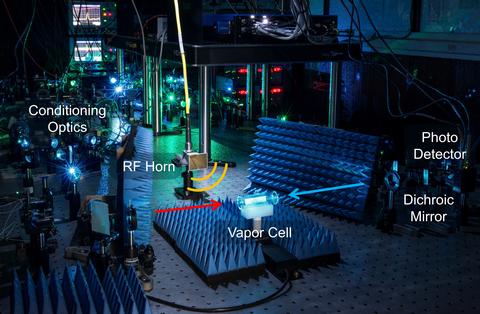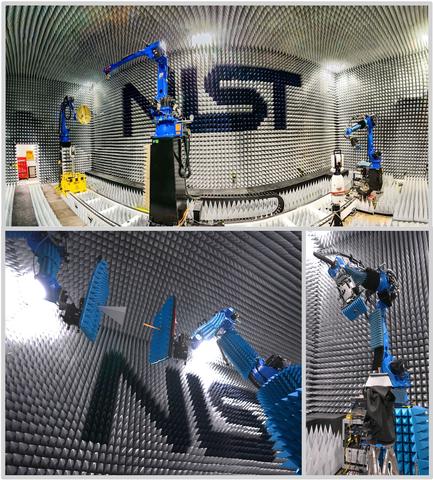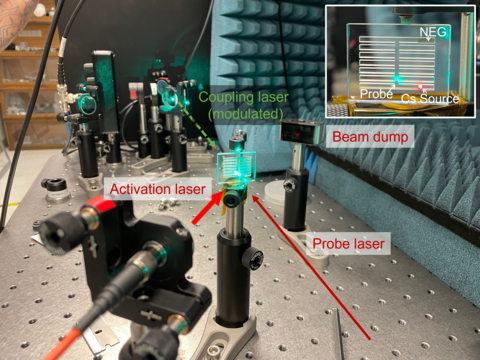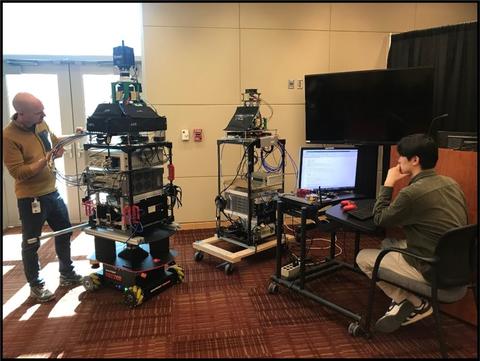Electromagnetic Fields Group
The Electromagnetic Fields Group measures, characterizes, and calibrates antennas and radiated fields of the type used in many high-performance communication, defense, aerospace, satellite, and wireless systems.

The Electromagnetic Fields Group conducts theoretical and experimental research necessary for the accurate measurement of free-space electromagnetic field quantities; for the characterization of antennas, probes and antenna systems; for the development of effective methods for electromagnetic compatibility assessment; for the assessment of electromagnetic and radio frequency (RF) systems, for the measurement of radiated noise; and for providing measurement services and calibrations for essential parameters. The group focuses on both conventional and quantum-based technologies. The group also preforms characterization and validation of quantum-base sensors.
The Electromagnetic Fields Group has a long heritage in advancing the understanding of RF behavior. Today its major focus is on developing new ways to characterize new emerging system in communications and other electromagnetic and RF technologies, this includes conventional systems and quantum systems. The Electromagnetic Fields Group faces new challenges as new spectrum bands in the tens and even hundreds of gigahertz (GHz) open up and as new types of modulation come into play, such as the spatial modulation with massive multiple-input, multiple-output (MIMO). The group has responded by inventing new ways to quickly characterize, measure and test these millimeter wavelengths.
MAJOR PROJECTS
ANTENNA METROLOGY PROJECT
The Antenna Metrology Project focuses on the measurement of antenna parameters which are necessary to accurately characterize systems that utilize wireless and free space transmission and reception of radio frequencies. This work promotes U.S. innovation and industrial competitiveness through supporting CTL focus areas on Fundamental Electromagnetic Technologies and Standards and Next Generation Wireless Systems and is aligned with several U.S. Critical and Emerging Technologies.
The Antenna Project continues a long history of fulfilling the National Metrology Institute (NMI) roll of developing, maintaining, and defining antenna parameter standards, calibrations, and measurement methodologies since the 1950s and has pioneered many of the most widely used antenna metrology techniques throughout the world today. It is widely recognized for developing and disseminating seminal and groundbreaking work in antenna metrology including antenna pattern near-field theory and techniques, antenna gain extrapolation theory and techniques, and modern robotic antenna measurement systems.

The Antenna Project works internationally with other NMIs through the Committee on Weights and Measures Mutual Recognition Arrangement (CIPM MRA) for standards development. The Antenna Project engages with U.S. industry, other U.S. government agencies, and academia through interagency and cooperative research and development agreements (CRADAs) and provides essential traceable antenna calibrations to customers through the internationally recognized Bureau International des Poids et Mesures (BIPM) antenna calibration service, SKU63100S and ISO 17025 certified measurement Quality System. The Antenna Project carries out measurements and calibrations at the state-of-the-art NIST Robotically Enhanced Antenna Laboratory for Metrology (REALM). REALM evolved from pioneering work in robotic-based antenna measurement systems by CTL, which now represents an expansive sub-discipline of antenna metrology, with the initial development of the NIST Configurable Robotic MilliMeter-wave Antenna (CROMMA) system. The REALM specializes in applying robotics-based approaches for developing antenna and free-space electromagnetic measurement techniques and fosters metrological innovations for next generation RF and millimeter wave antenna systems. The unique capabilities of REALM address on going and emerging measurement and calibration challenges.
RYDBERG ATOM –BASED QUANTUM SENSORS PROJECT

Calibrated RF electric field probes and antennas are currently limited by a complex, indirect traceability path, and require an arduous calibration chain relying on classical simulations and assumptions. Borrowing a technique from atomic spectroscopy called electromagnetically induced transparency (EIT), the Electromagnetic Fields Group can use atoms as a noninvasive field probe for directly International System of Units (SI)-traceable, self-calibrated RF electric field measurements over a huge range of frequencies, from direct current (DC) to terahertz (THz) frequencies. Furthermore, as sensitive field sensors, Rydberg atoms are promising for many applications beyond RF field probe calibrations. The Electromagnetic Fields Group is currently exploring communications reception, blackbody radiation characterization, RF cameras, DC/alternating current (AC) voltage standards, passive angle of arrival detection, RF power metrology, and vapor cell characterization and improvement studies.
FIELD STRENGTH METROLOGY PROJECT
RF field strength measurements are necessary to accurately characterize radiating systems. The mission of the RF Field Strength Metrology Project is to provide world’s best field strength measurements from 100 Kilohertz (kHz) to 1 THz, to advance basic field strength metrology research, and to support external customers. NIST calibrates electrically-small field probes from 10 megahertz (MHz) – 40 gigahertz (GHz) in Transverse Electromagnetic (TEM) cells and a fully anechoic chamber, as part of the Electromagnetic Field Strength Metrology Project.

The Field Strength Metrology Project is also building a first-of-its-kind quantum-based field antenna capable of directly measuring electric field strength with short SI traceability and potentially an order of magnitude lower uncertainties than current field probes. The Rydberg atom-based probe is an ultra-wideband, omnidirectional, all-dielectric, and compact receiving antenna that can measure amplitude, phase and polarization of modulated electric fields over a frequency range from MHz to THz. A comparison of the first prototype in the anechoic chamber demonstrated equivalence compared to the traditional calibration methods and achieved a low uncertainty. This fundamentally new approach to RF metrology promises to improve the sensitivity, precision, and ease of tests and calibrations of high-frequency field probes used for measuring radiated fields in next-generation 5G wireless systems, biomedical, and nanoelectronic systems, and environmental and other sensors.
CHANNEL SOUNDER METROLOGY

To leverage the increased bandwidth and to relieve congestion in existing RF bands 5G and 6G communications will seek to use ever-higher frequencies. Channel sounding measures the fundamental propagation characteristics of RF signals that are needed for successful deployment of NextG communications systems and to optimize the end-user experience. Because higher frequencies have higher propagation losses, digitally steerable phased array antennas featuring narrow beams and high directional gain are increasingly used to overcome these losses. Such controllable antennas are also attractive because of their potential for spatial sensing in Integrated Sensing and Communications (ISAC) applications. The channel measurement project focuses on the metrology and development of RF propagation measurements using phased array antennas at frequencies ranging from 15 GHz up to 140 GHz in order to support model development for communications and sensing technologies. Channel sounding measurements and models are directly provided to industry stakeholders through the next-G channel model alliance and directly support the development of communications standards at organizations including the 3rd Generation Partnership Project (3GPP), International Telecommunications Union (ITU), and Institute of Electrical and Electronics Engineers (IEEE).
METROLOGY FOR WIRELESS SYSTEMS PROJECT

The metrology for wireless systems project (MWS) develops the measurements, analysis, and traceability for next generation communication signals. The traceability of modulated signal measurements (communication signals) to primary standards is paramount to allow global measurement standards and rigorous uncertainties when incorporating devices into critical communication infrastructure such as medical or space applications. The Electromagnetic Fields Group develops traceability in both magnitude and phase, vector quantities, as well as accounting for non-linear behavior, especially at millimeter-wave frequencies. The project focuses on developing over-the-air test methods at next generation frequencies. The over-the-air testing is the only way to account for both a lack of ports at millimeter wave frequencies (given the small size of devices) and the distortion caused by integrated antennas. The work of the MWS project is key to leading global measurement standards for metrics and measurements. The work focuses on four key areas: 1. Traceability for Modulated Fields, 2. The Traceable Testbed for Industrial Internet of Things (IIoT), 3. Supply Chain Security Through RF Fingerprinting, 4. Over-the-Air Testing in Reverberation Chambers.
FACILITIES/TOOLS
• Quantum Field Antenna Probe Laboratory
• Electric Field Probe Laboratory: anechoic and reverberation chambers
• TEM and GTEM cells
• Antenna and Communication Metrology Laboratory
• Quantum Field Antenna Probe Laboratory
• Configurable Robotic Millimeter-wave Antenna facility (CROMMA)
• Channel Sounding Laboratory
• Large Antenna Positioning System
• Wireless System Metrology Laboratory
• Both Cs and Rb Rydberg atom systems
Contacts
Group Leader
-
(303) 497-6184

